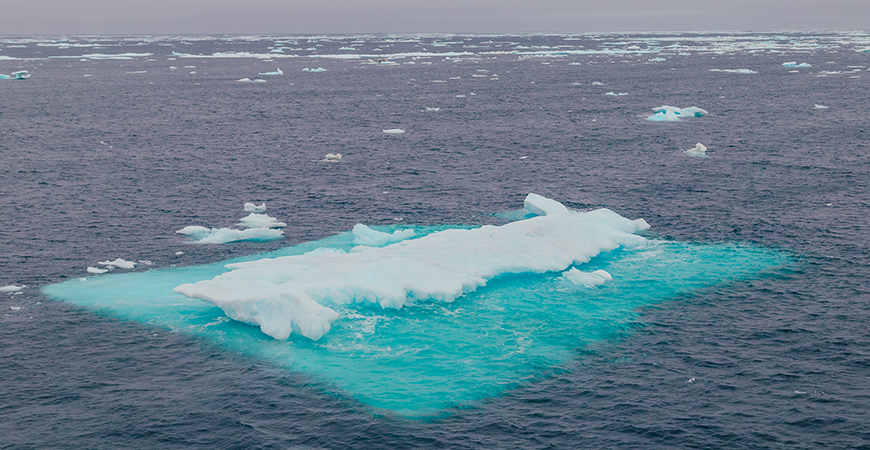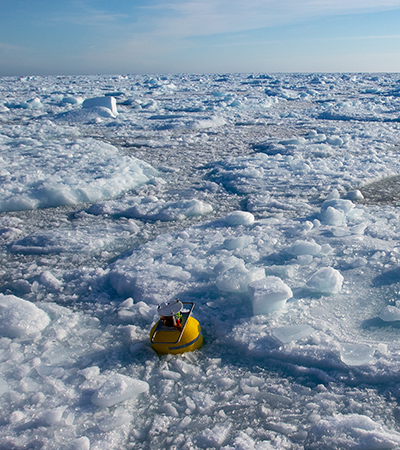| 正文(英文) |
 Arctic Ocean sea ice seen during 2018 SODA cruise. Photo: San Nguyen
The Arctic has experienced the warming effects of global climate change faster than any other region on the planet. Current and former scientists at Scripps Institution of Oceanography at the University of California San Diego have developed a new theory aided by computer simulations and observations that helps explain why this occurs.
A team led by Scripps Oceanography graduate student Emma Beer observed the changes taking place within the Arctic Ocean, which is largely covered by sea ice for most of the year. There, an unusual situation exists where the water is warm at depth and cold near the surface. The deeper waters are fed by the relatively warm Pacific and Atlantic Oceans, whereas the near-surface waters are in contact with the sea ice and remain close to the freezing point. Heat flows upward from the warmer water to the colder water.
The scientists found that the deeper water is getting still warmer as a consequence of climate change, but the near-surface water below the sea ice remains close to the freezing point. The increasing difference in temperature leads to a greater upward flow of heat. Beer, Scripps climate scientist Ian Eisenman, and former Scripps postdoctoral researcher Till Wagner estimate that this phenomenon is responsible for about 20 percent of the amplification of global warming that occurs in the Arctic.
“Global climate model projections of the amplification of Arctic warming vary widely across current models,” said Beer. “What we do here is try to understand one process contributing to this phenomenon as a step to help better constrain future projections.”
The Arctic amplification of global warming has long been observed, and scientists have previously attributed it to several causes including the melting of sea ice. As the bright white ice disappears for longer periods of the year, the dark surface waters beneath it absorb sunlight rather than reflecting it back to space as the ice does. This phenomenon is called the ice-albedo feedback.
“While previous work has found mechanisms related to the surface and the atmosphere that cause Arctic amplification, our finding is that there is also a fundamental reason why the ocean causes polar amplification when the polar region is covered with sea ice,” Eisenman said of the National Science Foundation-supported study.
This finding from researchers affiliated with the Scripps Polar Center was inspired by direct observations made by oceanographers at Scripps Oceanography and elsewhere during recent expeditions to the Arctic Ocean. The 2015 ArcticMix and 2018 SODA cruises to the Arctic Ocean revealed evidence that the body of water is becoming more turbulent as sea ice diminishes. That lets warm water from other oceans interact more easily with cold surface waters.
It is also one among a number of new studies characterizing the Arctic warming trend. In January, Scripps Oceanography climate modeler Mark England was part of a team that quantified for the first time how much chlorofluorocarbons (CFCs) have also influenced acceleration of the Arctic warming trend. The influence is expected to decline since measures to phase out CFC use began in 1989.
Wagner is now a researcher at the University of North Carolina in Wilmington, N.C. The National Science Foundation-funded study appears Feb. 28 in the journal Geophysical Research Letters.
Note to broadcast and cable producers: University of California San Diego provides an on-campus satellite uplink facility for live or pre-recorded television interviews. Please phone or email the media contact listed above to arrange an interview.
About Scripps OceanographyScripps Institution of Oceanography at the University of California San Diego, is one of the oldest, largest, and most important centers for global science research and education in the world. Now in its second century of discovery, the scientific scope of the institution has grown to include biological, physical, chemical, geological, geophysical, and atmospheric studies of the earth as a system. Hundreds of research programs covering a wide range of scientific areas are under way today on every continent and in every ocean. The institution has a staff of more than 1,400 and annual expenditures of approximately $195 million from federal, state, and private sources. Scripps operates oceanographic research vessels recognized worldwide for their outstanding capabilities. Equipped with innovative instruments for ocean exploration, these ships constitute mobile laboratories and observatories that serve students and researchers from institutions throughout the world. Birch Aquarium at Scripps serves as the interpretive center of the institution and showcases Scripps research and a diverse array of marine life through exhibits and programming for more than 430,000 visitors each year. Learn more at scripps.ucsd.edu and follow us at Facebook, Twitter, and Instagram. About UC San DiegoAt the University of California San Diego, we embrace a culture of exploration and experimentation. Established in 1960, UC San Diego has been shaped by exceptional scholars who aren’t afraid to look deeper, challenge expectations and redefine conventional wisdom. As one of the top 15 research universities in the world, we are driving innovation and change to advance society, propel economic growth and make our world a better place. Learn more at www.ucsd.edu.
This story appears in explorations now, Scripps Institution of Oceanography's award-winning ocean and earth science magazine. Sign up to receive our free monthly story roundup.
|







修改评论